The roads radiating off the crossroads at Ballycoogue in south Wicklow hold a special place in my heart. It was in this small hilltop crossroads community that I started primary school, made my First Communion and attended my first dance.
The old school is now a community centre and the ‘new’ school, which opened in 1968, is still going strong – as is the church. The hall, post office and grocery shop are long gone. Community spirit is strong though, and can be seen in the beautifully kept graveyard, community centre and approaches to the crossroads.
The land is free draining, with good carrying capacity, but on the higher ground vicious north and east winds can make it inhospitable and susceptible to heavy snow. Dairying is the dominant farm enterprise and in my lifetime, land high up the hills – which might otherwise have gone to forestry – has been reclaimed for grazing.
Gold rush
Farming has been going strong here for millennia, proof of which was the discovery of a Bronze Age burial cairn in Ballinagore. It was here too that a mini gold rush occurred in 1795 when in a few weeks 486kg of gold, including a nugget weighing 682g, was panned from the Gold Mines River. Tourists continue to test their panning skills here to this day
Changing times
So it was a pleasure to join neighbours and old school friends in Martin Byrne’s kitchen for this Round the Kitchen Table chat from Co Wicklow.
Martin and his brother Eddie farm in Ballinasillogue and Martin reckons there’s been Byrnes farming here for over 300 years. “At one stage, there were 46 houses in the two nearest townlands, today there are four houses here and a few holiday homes in Ballinagore”.
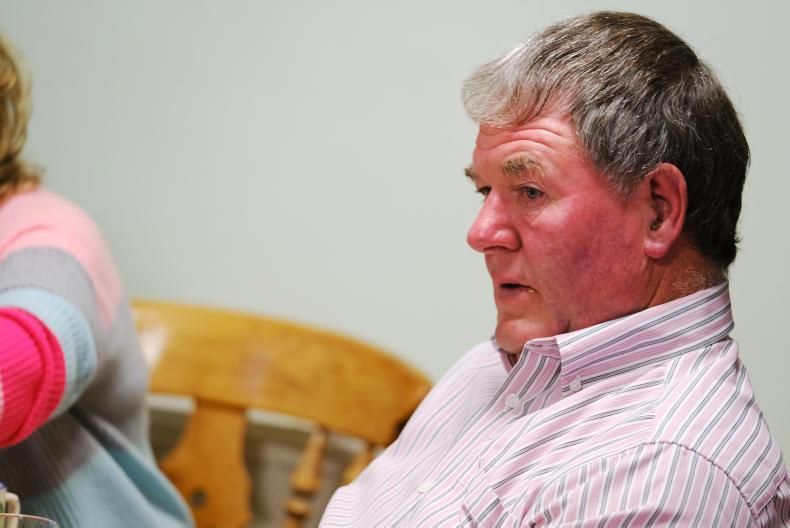
Martin Byrne. \ Ramona Farrelly
Originally in sheep and cattle, the Byrnes moved to dairying in 1982. This area would have marked the boundary between liquid milk supplies going by train to Dublin and the expansion of creamery milk processing over the county border in Wexford.
“Quotas arrived so 1982 wasn’t the best year to be getting into cows. The quotas held back expansion for most people,” he says. Martin supplies Glanbia and his herd has grown from 30 to 65 cows. He keeps replacement heifers and two-year-olds are finished on the farm. He used keep 200 ewes but a bad back put paid to that a few years ago.
New Zealand experience
James Wolohan and his parents, Jimmy and Breda, are dairy farmers in the townland of Ballykillageer. Their milking parlour was built in 1976 and James says his parents were only getting going when the milk quotas hit. So sheep and cattle production were the main enterprises as well as 160 New York dressed oven-ready turkeys for the Christmas market.
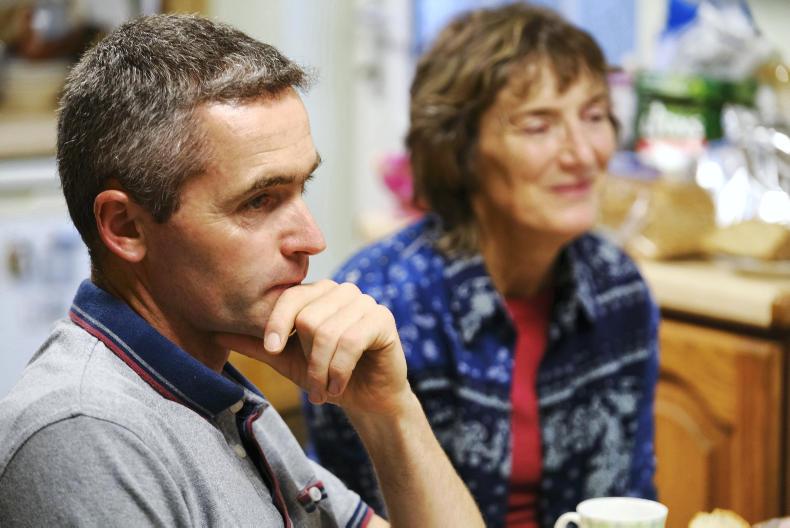
James Wolohan and Anne Murphy. \ Ramona Farrelly
James Wolohan did his Green Cert in Warrenstown College followed by a dairy herd management course in Pearse Heath in Cheshire.
“I liked dairying and thought dairy farm management was a good career choice. I managed several dairy farms here and in the UK but I didn’t really like the UK preference for high-yielding pedigree cows, kept indoors all year long.”
James won a Stephen Cullinane Scholarship and found himself working with Sharon and Alistair Rayne in New Zealand.
“I started at the bottom, but what I learned from Sharon and Alistair over two calving seasons convinced me to go into dairy farming,” says James.
That was in 2001 and James continued to manage dairy herds in the UK before coming home when he married Julie in 2004. In the intervening years, cow numbers have gradually increased to 90 and James farms and works with a local pharmaceutical company. He is dad to three young children.
A great place to live
Anne Murphy has always lived in the townland of Balliasillogue and she cared for her father Jack and Aunt Lizzie until their death. She and her brother Vincent inherited the farm equally. It’s a high farm and that can create its own problems.
In February 2018 a shed fell in as the snow was coming in so fast. “Some of the hill is 1,000ft over sea level and that can be tough when the east wind blows. But it’s a really beautiful place with great neighbours, a great community and is a great place to live,” says Anne.
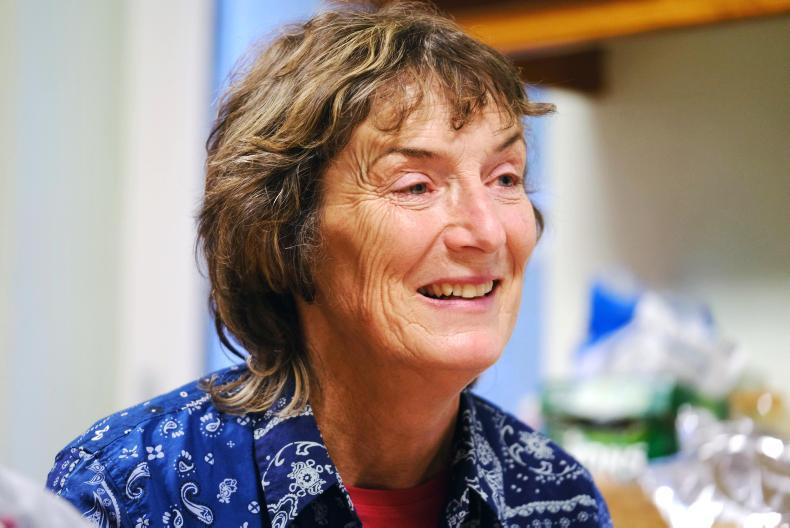
Anne Murphy. \ Ramona Farrelly
Anne keeps the highly prolific Lleyn ewes and crosses them with Texel rams. “The sheep have built sheds and reseeded the farm. They’ve carried everything, even the sucklers this year.” Anything that’s labour saving is a hit with Anne. She has a self-propelled feeder to feed silage and the sheep and cattle are housed on plastic slats.
She also breeds show jumpers and eventers and says it’s been a long road as she continues to upgrade the breed. She has three to four brood mares and keeps the young progeny until they are three-years-old and lunging over poles.
“I use the ‘Ogue’ prefix as my brand and this year it’s really come good and we have had lots of winners at some high profile shows.”
Positive outlook
Mary Condren describes herself as a blow-in from Rathdowney, Co Laois. From a farming background she qualified as a general nurse and worked in what was the Richmond in Dublin and in Scotland and Wales. She also did a spell in Australia and when she was there in 1986 there were 150 Irish nurses working in St Vincent’s Hospital in Melbourne. So not much changes.
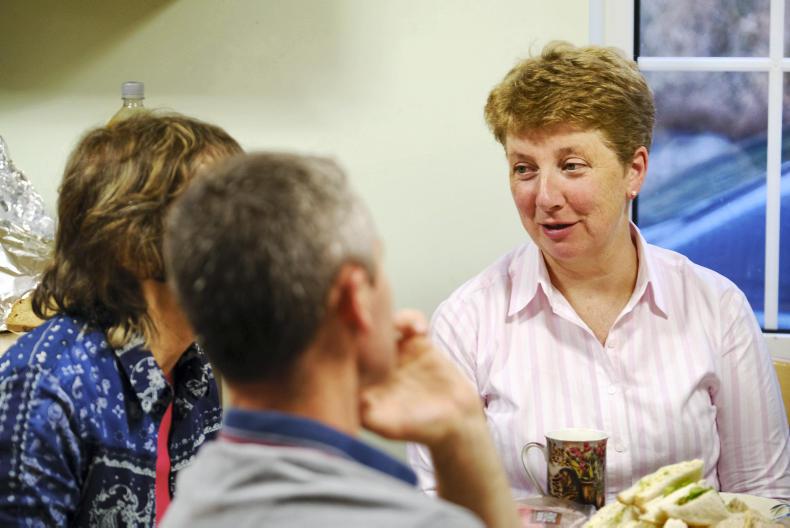
Mary Condren. \ Ramona Farrelly
Mary married dairy farmer Paddy Condren in 1997 and moved into the family farm in Ballykillageer. They have two children, Mary-Kate is doing dairy business in UCD and Kieran has just started in Kildalton.
“Paddy’s parents, Eileen and Ned, bought the farm in 1958 and they started with tillage and contracting. They were also big into hens and egg production.
“They turned to dairying in the mid-1960s and 2019 marks our last year in 365-day production as we have opted for a spring-calving herd. Cow numbers have increased from 70 to 138 since the end of quotas.”
In 2000, Mary and Paddy converted some outhouses into self-catering units and Mary says it’s been “brilliant”.
“We have visitors from all over the world and lots of repeats. They love watching the cows being milked. And going for walks. So far so good with Brexit as our UK numbers haven’t been hit.”
Tough times for suckler to beef
Eugene Clune is 35 and farms with his wife Colleen and parents Catherine and Frank. He has three young children. His grandfather William, who was from Co Clare moved up to Woodenbridge in the 1920s so as to supply liquid milk to the Dublin market.
He died in 1951 leaving a large family behind. Many of them emigrated and a few went farming. Eugene, who farms in the townland of Ballinvalley, says he is the only one of the third-generation farming today.
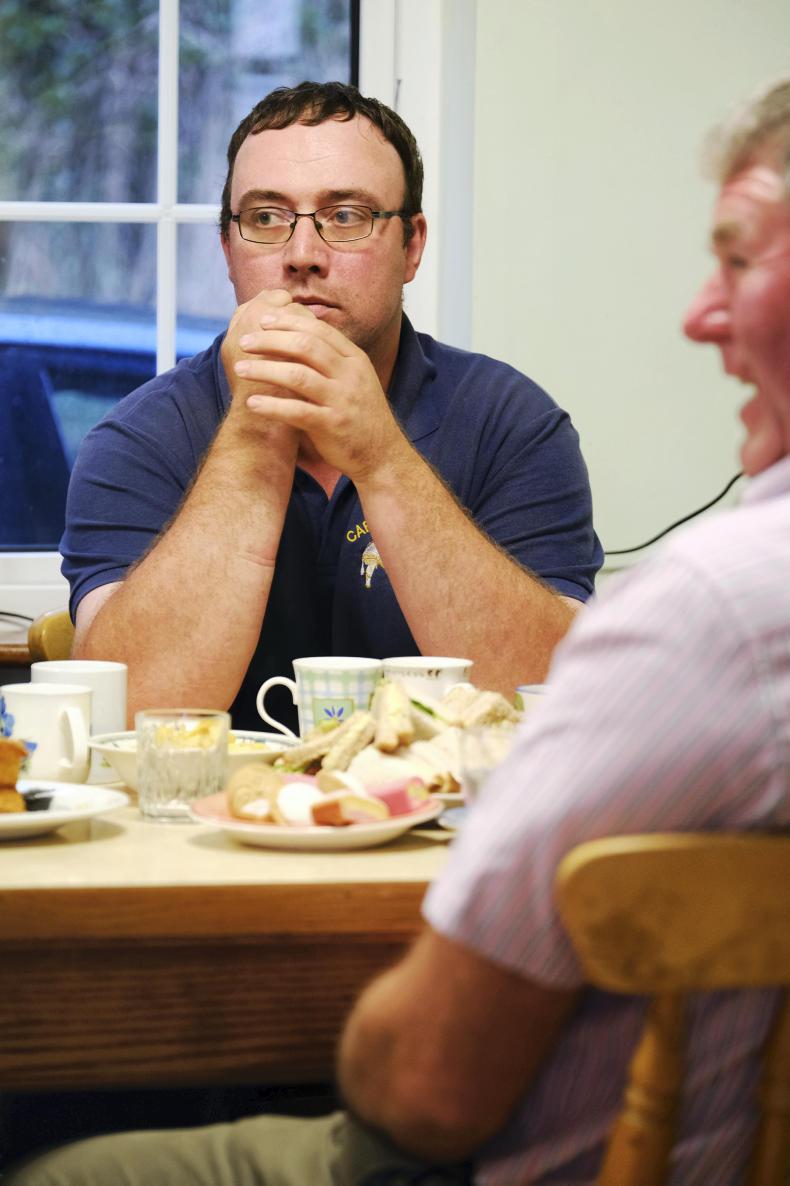
Eugene Clune. \ Ramona Farrelly
“I’ve always wanted to farm. I did a year of ag science in UCD but it wasn’t for me. And I came back to farm. We’re in sucklers to beef and it hasn’t been easy. The rise in dairy cow numbers and the dairy beef they produce has hit the traditional beef trade hard.”
Eugene also works with Carnew Mart and he says the psyche of dairy farmers has changed. “They used to be more mixed farming but now it’s heading for 150 to 400 cows.
“They sell calves by the hundred and that can depress the trade. Every beef farmer I know is working and so is his wife. Is it too much to ask that farmers can make enough to rear a family?
“Land rental is about €300/ac and the beef lads can’t pay that. In the mart we sell out 30 to 40 suckler herds every year and that’s from a small area. Many of them are going dairying. As for trees, unfortunately they could be the future, but that’s a whole other issue,” he says.
Looking forward
Looking to now and the future Anne Murphy wants to emphasis the value of farming to the community. “We have a patchwork of farms across a few townlands and there’s so much investment, so much enterprise, it’s like a beehive. And all of it keeps the community alive.”
Mary agrees, but says the growing divide between farmers isn’t good for anyone. “Milk has had its poor days and they could happen again. Even with that I would encourage both our children to go farming if they are happy to do it.”
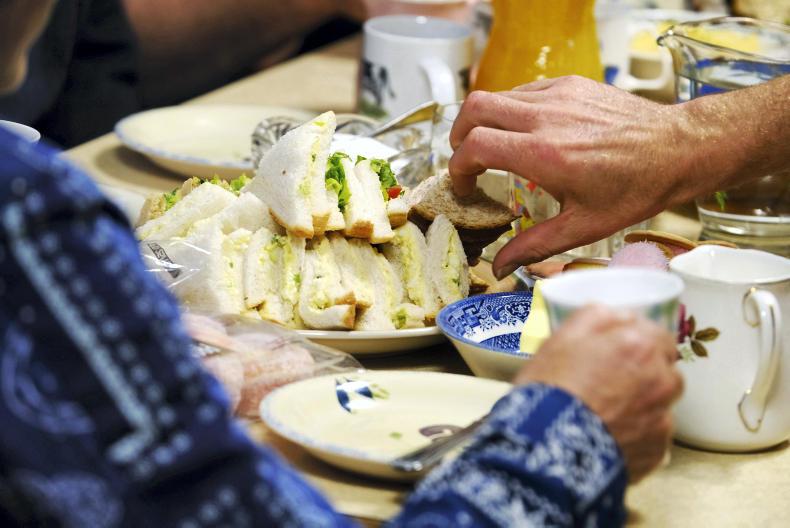
Chatting around the kitchen table. \ Ramona Farrelly
There’s consensus around the table that sheep and cattle are under pressure and that dairying has the best prospects for the future. “Looking ahead 10 years, I’d hope to be still milking in ten years’ time,” says Martin Byrne. “I’d keep to the same numbers though,” he adds.
Dairy future
James Wolohan says cow numbers must increase if you want to survive. “Efficiency is critical to getting a good return. I don’t think too many dairy farmers are trying to over-do things, most are up 20-25%%. They are not going mad.”
He says some farmers are on a fine edge with big borrowings so it’s hard to scale up, but you have to. “The goal posts on standards and the environment will keep changing and that’s a big challenge for the next decade.
Mary sees the need for a “less busy” type of farming. “We need to farm in such a way that breaks can be taken. That’s not simple as there’s a serious shortage of good help. It’s not good to be farming on your own day-in day-out – you’d have mental health issues before you’d know it.
“We need to develop farm systems that allow us produce more but in a safe, efficient way.”
All also agree that farming has become easier thanks to agri-technology but there’s still much to be exploited here.
We love this place, it’s picture-postcard perfect and we hope it’s never taken by the trees
Having a bright outlook is important to Anne. “I only know how to live off my farm. I scraped and saved for everything and did it without any off-farm job but I wouldn’t be able to rear a family on what I earn from the farm.”
All are proud of the fight back to keep this crossroads community alive. There’s a hall committee, tourism group, a pure mile group and 25 people trained as first responders. Both Macra and the ICA are going strong and the bi-century of the church was celebrated with a massive party.
Anne Murphy sums up for everyone: “We love this place, it’s picture-postcard perfect and we hope it’s never taken by the trees.”
The roads radiating off the crossroads at Ballycoogue in south Wicklow hold a special place in my heart. It was in this small hilltop crossroads community that I started primary school, made my First Communion and attended my first dance.
The old school is now a community centre and the ‘new’ school, which opened in 1968, is still going strong – as is the church. The hall, post office and grocery shop are long gone. Community spirit is strong though, and can be seen in the beautifully kept graveyard, community centre and approaches to the crossroads.
The land is free draining, with good carrying capacity, but on the higher ground vicious north and east winds can make it inhospitable and susceptible to heavy snow. Dairying is the dominant farm enterprise and in my lifetime, land high up the hills – which might otherwise have gone to forestry – has been reclaimed for grazing.
Gold rush
Farming has been going strong here for millennia, proof of which was the discovery of a Bronze Age burial cairn in Ballinagore. It was here too that a mini gold rush occurred in 1795 when in a few weeks 486kg of gold, including a nugget weighing 682g, was panned from the Gold Mines River. Tourists continue to test their panning skills here to this day
Changing times
So it was a pleasure to join neighbours and old school friends in Martin Byrne’s kitchen for this Round the Kitchen Table chat from Co Wicklow.
Martin and his brother Eddie farm in Ballinasillogue and Martin reckons there’s been Byrnes farming here for over 300 years. “At one stage, there were 46 houses in the two nearest townlands, today there are four houses here and a few holiday homes in Ballinagore”.

Martin Byrne. \ Ramona Farrelly
Originally in sheep and cattle, the Byrnes moved to dairying in 1982. This area would have marked the boundary between liquid milk supplies going by train to Dublin and the expansion of creamery milk processing over the county border in Wexford.
“Quotas arrived so 1982 wasn’t the best year to be getting into cows. The quotas held back expansion for most people,” he says. Martin supplies Glanbia and his herd has grown from 30 to 65 cows. He keeps replacement heifers and two-year-olds are finished on the farm. He used keep 200 ewes but a bad back put paid to that a few years ago.
New Zealand experience
James Wolohan and his parents, Jimmy and Breda, are dairy farmers in the townland of Ballykillageer. Their milking parlour was built in 1976 and James says his parents were only getting going when the milk quotas hit. So sheep and cattle production were the main enterprises as well as 160 New York dressed oven-ready turkeys for the Christmas market.

James Wolohan and Anne Murphy. \ Ramona Farrelly
James Wolohan did his Green Cert in Warrenstown College followed by a dairy herd management course in Pearse Heath in Cheshire.
“I liked dairying and thought dairy farm management was a good career choice. I managed several dairy farms here and in the UK but I didn’t really like the UK preference for high-yielding pedigree cows, kept indoors all year long.”
James won a Stephen Cullinane Scholarship and found himself working with Sharon and Alistair Rayne in New Zealand.
“I started at the bottom, but what I learned from Sharon and Alistair over two calving seasons convinced me to go into dairy farming,” says James.
That was in 2001 and James continued to manage dairy herds in the UK before coming home when he married Julie in 2004. In the intervening years, cow numbers have gradually increased to 90 and James farms and works with a local pharmaceutical company. He is dad to three young children.
A great place to live
Anne Murphy has always lived in the townland of Balliasillogue and she cared for her father Jack and Aunt Lizzie until their death. She and her brother Vincent inherited the farm equally. It’s a high farm and that can create its own problems.
In February 2018 a shed fell in as the snow was coming in so fast. “Some of the hill is 1,000ft over sea level and that can be tough when the east wind blows. But it’s a really beautiful place with great neighbours, a great community and is a great place to live,” says Anne.

Anne Murphy. \ Ramona Farrelly
Anne keeps the highly prolific Lleyn ewes and crosses them with Texel rams. “The sheep have built sheds and reseeded the farm. They’ve carried everything, even the sucklers this year.” Anything that’s labour saving is a hit with Anne. She has a self-propelled feeder to feed silage and the sheep and cattle are housed on plastic slats.
She also breeds show jumpers and eventers and says it’s been a long road as she continues to upgrade the breed. She has three to four brood mares and keeps the young progeny until they are three-years-old and lunging over poles.
“I use the ‘Ogue’ prefix as my brand and this year it’s really come good and we have had lots of winners at some high profile shows.”
Positive outlook
Mary Condren describes herself as a blow-in from Rathdowney, Co Laois. From a farming background she qualified as a general nurse and worked in what was the Richmond in Dublin and in Scotland and Wales. She also did a spell in Australia and when she was there in 1986 there were 150 Irish nurses working in St Vincent’s Hospital in Melbourne. So not much changes.

Mary Condren. \ Ramona Farrelly
Mary married dairy farmer Paddy Condren in 1997 and moved into the family farm in Ballykillageer. They have two children, Mary-Kate is doing dairy business in UCD and Kieran has just started in Kildalton.
“Paddy’s parents, Eileen and Ned, bought the farm in 1958 and they started with tillage and contracting. They were also big into hens and egg production.
“They turned to dairying in the mid-1960s and 2019 marks our last year in 365-day production as we have opted for a spring-calving herd. Cow numbers have increased from 70 to 138 since the end of quotas.”
In 2000, Mary and Paddy converted some outhouses into self-catering units and Mary says it’s been “brilliant”.
“We have visitors from all over the world and lots of repeats. They love watching the cows being milked. And going for walks. So far so good with Brexit as our UK numbers haven’t been hit.”
Tough times for suckler to beef
Eugene Clune is 35 and farms with his wife Colleen and parents Catherine and Frank. He has three young children. His grandfather William, who was from Co Clare moved up to Woodenbridge in the 1920s so as to supply liquid milk to the Dublin market.
He died in 1951 leaving a large family behind. Many of them emigrated and a few went farming. Eugene, who farms in the townland of Ballinvalley, says he is the only one of the third-generation farming today.

Eugene Clune. \ Ramona Farrelly
“I’ve always wanted to farm. I did a year of ag science in UCD but it wasn’t for me. And I came back to farm. We’re in sucklers to beef and it hasn’t been easy. The rise in dairy cow numbers and the dairy beef they produce has hit the traditional beef trade hard.”
Eugene also works with Carnew Mart and he says the psyche of dairy farmers has changed. “They used to be more mixed farming but now it’s heading for 150 to 400 cows.
“They sell calves by the hundred and that can depress the trade. Every beef farmer I know is working and so is his wife. Is it too much to ask that farmers can make enough to rear a family?
“Land rental is about €300/ac and the beef lads can’t pay that. In the mart we sell out 30 to 40 suckler herds every year and that’s from a small area. Many of them are going dairying. As for trees, unfortunately they could be the future, but that’s a whole other issue,” he says.
Looking forward
Looking to now and the future Anne Murphy wants to emphasis the value of farming to the community. “We have a patchwork of farms across a few townlands and there’s so much investment, so much enterprise, it’s like a beehive. And all of it keeps the community alive.”
Mary agrees, but says the growing divide between farmers isn’t good for anyone. “Milk has had its poor days and they could happen again. Even with that I would encourage both our children to go farming if they are happy to do it.”

Chatting around the kitchen table. \ Ramona Farrelly
There’s consensus around the table that sheep and cattle are under pressure and that dairying has the best prospects for the future. “Looking ahead 10 years, I’d hope to be still milking in ten years’ time,” says Martin Byrne. “I’d keep to the same numbers though,” he adds.
Dairy future
James Wolohan says cow numbers must increase if you want to survive. “Efficiency is critical to getting a good return. I don’t think too many dairy farmers are trying to over-do things, most are up 20-25%%. They are not going mad.”
He says some farmers are on a fine edge with big borrowings so it’s hard to scale up, but you have to. “The goal posts on standards and the environment will keep changing and that’s a big challenge for the next decade.
Mary sees the need for a “less busy” type of farming. “We need to farm in such a way that breaks can be taken. That’s not simple as there’s a serious shortage of good help. It’s not good to be farming on your own day-in day-out – you’d have mental health issues before you’d know it.
“We need to develop farm systems that allow us produce more but in a safe, efficient way.”
All also agree that farming has become easier thanks to agri-technology but there’s still much to be exploited here.
We love this place, it’s picture-postcard perfect and we hope it’s never taken by the trees
Having a bright outlook is important to Anne. “I only know how to live off my farm. I scraped and saved for everything and did it without any off-farm job but I wouldn’t be able to rear a family on what I earn from the farm.”
All are proud of the fight back to keep this crossroads community alive. There’s a hall committee, tourism group, a pure mile group and 25 people trained as first responders. Both Macra and the ICA are going strong and the bi-century of the church was celebrated with a massive party.
Anne Murphy sums up for everyone: “We love this place, it’s picture-postcard perfect and we hope it’s never taken by the trees.”







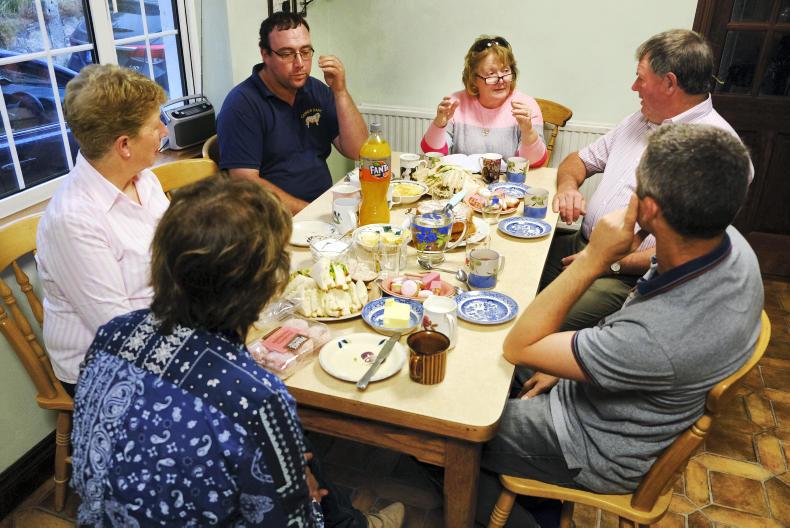




 This is a subscriber-only article
This is a subscriber-only article










SHARING OPTIONS: